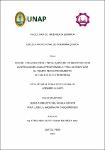| dc.contributor.advisor | Salas Barrera, Fernando Javier | |
| dc.contributor.author | Del Águila Zárate, Jesús Ausberto | |
| dc.contributor.author | Haquiwara Chuquipiondo, Irma Luzmila | |
| dc.date.accessioned | 2022-09-13T17:56:14Z | |
| dc.date.available | 2022-09-13T17:56:14Z | |
| dc.date.issued | 2022 | |
| dc.identifier.uri | https://hdl.handle.net/20.500.12737/8305 | |
| dc.description.abstract | The main objective of the present work of thesis was: laying plans constructing and installing a prototype with programmable logic controller to automate the passage of time of functioning of four electric pumps. In the present investigation, firstly, a revision of the at one PLC has been done (ladder and BDF); from now on a sketch of the prototype automated of four electric pumps, where it was described to each one of his main components came true; straightaway, came true the design and simulation of the electric circuit in the programmable logic controller (PLC), with the aim of verifying activation and deactivation of the physical exits of the PLC according to what's programmed, this in turn allowed determining the quantity of physical receipts and expenditures that were used in the PLC; from now on, the relation between the state of every an one belonging to the physical exits of the PLC was determined: Q1, Q2, Q3 and Q4, with the state of the check mark of rabbetting (M1) and the passage of time of functioning of the four electric pumps. Finally, seven performance testings of the prototype automated, where the residue of the passage of time of functioning of the four electric pumps proved to be similar to zero have come true, which indicates that the four electric pumps do not have any delays when catches fire or becoming extinguished, according to the passage of time programmed in the timers T001, T002 y T003, this proved that the PLC works with an efficiency of the 100 %. In this way it came true with the realistic general and he tried the general hypothesis. | en_US |
| dc.description.abstract | El objetivo principal del presente trabajo de tesis fue: diseñar, construir e instalar un prototipo con controlador lógico programable para automatizar el tiempo de funcionamiento de cuatro electrobombas. En la presente investigación, primeramente, se ha hecho una revisión de los lenguajes de programación orientados a un PLC (ladder y BDF); a continuación se realizó un esquema del prototipo automatizado de cuatro electrobombas, donde se describió a cada uno de sus componentes principales; seguidamente, se realizó el diseño y simulación del circuito eléctrico en el controlador lógico programable (PLC), con el fin de verificar la activación y desactivación de las salidas físicas del PLC de acuerdo a lo programado; esto a su vez permitió determinar la cantidad de entradas y salidas físicas que se utilizaron en el PLC; a continuación, se determinó la relación entre el estado de cada una de las salidas físicas del PLC: Q1, Q2, Q3 y Q4, con el estado de la marca de enclavamiento (M1) y el tiempo de funcionamiento de las cuatro electrobombas. Por último, se han realizado siete pruebas de funcionamiento del prototipo automatizado, donde el residuo del tiempo de funcionamiento de las cuatro electrobombas resultó igual a cero, lo cual indica que las cuatro electrobombas no tienen ningún retardo al prenderse o apagarse, de acuerdo al tiempo programado en los temporizadores T001, T002 y T003, esto probó que el PLC funciona con una eficiencia del 100 %. De esta forma se cumplió con el objetivo general y probó la hipótesis general. | es_PE |
| dc.format | application/pdf | es_PE |
| dc.language.iso | spa | es_PE |
| dc.publisher | Universidad Nacional de la Amazonía Peruana | es_PE |
| dc.rights | info:eu-repo/semantics/openAccess | * |
| dc.rights.uri | https://creativecommons.org/licenses/by/4.0/ | * |
| dc.subject | Diseños industriales | es_PE |
| dc.subject | Prototipos | es_PE |
| dc.subject | Instalación | es_PE |
| dc.subject | Controladores programables | es_PE |
| dc.subject | Ingeniería hidráulica | es_PE |
| dc.title | Diseño, construcción e instalación de un prototipo con controlador lógico programable para automatizar el tiempo de funcionamiento de cuatro electrobombas | es_PE |
| dc.type | info:eu-repo/semantics/bachelorThesis | es_PE |
| thesis.degree.discipline | Ingeniería Química | es_PE |
| thesis.degree.grantor | Universidad Nacional de la Amazonía Peruana. Facultad de Ingeniería Química | es_PE |
| thesis.degree.name | Ingeniero(a) Químico(a) | es_PE |
| dc.subject.ocde | https://purl.org/pe-repo/ocde/ford#1.04.05 | es_PE |
| dc.subject.ocde | https://purl.org/pe-repo/ocde/ford#2.04.02 | es_PE |
| renati.author.dni | 74070947 | |
| renati.author.dni | 72197596 | |
| renati.advisor.orcid | https://orcid.org/0000-0002-0177-3553 | |
| renati.advisor.dni | 05415003 | |
| renati.type | https://purl.org/pe-repo/renati/type#tesis | es_PE |
| renati.discipline | 531026 | es_PE |
| renati.level | https://purl.org/pe-repo/renati/level#tituloProfesional | es_PE |
| renati.juror | Flores Bernuy, Hugo Emerson | |
| renati.juror | Pérdiz Dávila, José Manuel | |
| renati.juror | García Pérez, Víctor | |
| dc.publisher.country | PE | es_PE |


